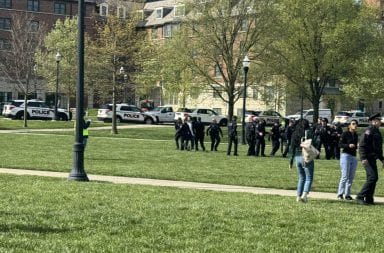Ohio State is far from the first school to be charged with NCAA infractions for violations committed by its football program. Other programs have had penalties ranging from small suspensions to the “death penalty,” but precedents set by NCAA cases could influence the organization’s final ruling on OSU.
On Aug. 12, a group of university representatives, including interim coach Luke Fickell and former coach Jim Tressel, will travel to Indianapolis to make its case to the NCAA’s Committee on Infractions.
The NCAA’s Notice of Allegations, sent to OSU President E. Gordon Gee on April 21, detailed the charges brought against the university. In the report, the NCAA said Tressel failed to behave with “honesty and integrity,” and knowingly played ineligible players, including Terrelle Pryor, Dan Herron, DeVier Posey, Solomon Thomas and Mike Adams. The players are suspended for the first five games of the 2011 season for selling memorabilia and receiving improper benefits.
The report also revealed that OSU may be designated as a “repeat offender” because of coach Jim O’Brien and 2006 Heisman Trophy-winning quarterback Troy Smith. O’Brien gave $6,000 to recruit’s mother, later forcing the Buckeyes to vacate their 2001 Final Four appearance and season wins. Repeat offenders generally receive harsher penalties.
Absent from the report were the terms “lack of institutional control” and “failure to monitor,” which can indicate large-scale violations and equally large penalties.
If the ongoing NCAA investigation uncovers a widespread problem within the program, “lack of institutional control” can still be applied to OSU.
Sports Illustrated recently reported that OSU’s violations extended beyond the six players suspended next season. The report said as many as 28 players received improper benefits since 2002, including nine current players.
Josephine Potuto, who has served on the NCAA Division I Committee on Infractions since 2006, said the new allegations could lead to an extended investigation.
“I would say, given what’s been reported in the papers and other media, I would guess there’s a chance the hearing won’t be held in August,” Potuto said.
Potuto also said that, if the NCAA decided to investigate further, the hearing could be delayed.
Michael Buckner, a lawyer who specializes in sports law, said the alleged violations eventually could lead to OSU being cited for “lack of institutional control.”
“These are just new allegations,” Buckner said. “Although they have been published from reputable media organizations, the NCAA and OSU still must conduct their own investigation, interview witnesses, collect documents and verify those allegations before any time of institutional control allegations are added to the case.”
In 2010, the USC football program was cited for “lack of institutional control” for violations primarily involving running back Reggie Bush. The program received a two-year postseason-bowl ban and faced reduction of 30 scholarships over three years.
Chris Dufresne, who covers USC football for The Los Angeles Times, said there are similarities between the two cases.
“What you have in common are two major power football universities where football is king and needs to be protected at all times,” Dufresne said. “But you have to wonder, ‘At what cost?'”
Dufresne said whether OSU is cited for “lack of institutional control” depends on several factors.
“It’s going to depend on whether it can be isolated to one person,” Dufresne said. “If it’s just Jim Tressel and no one else was really involved, then it’s on him. But it all depends on how much it bleeds into the rest of the administration.”
One thing that may benefit OSU is that the university self-reported the violations in December, whereas USC denied any wrongdoing.
“Ohio State initially did self-report this in December,” Dufresne said. “How they did it and how they perceived it and managed it is in question. … USC basically said they never did anything wrong.”
Despite the self-reported violations, Dufresne said OSU still could face harsher penalties than USC because Tressel was a central figure in the violations.
“Given what has been reported and what, I think, is being acknowledged, the head coach had players compete when they were ineligible,” Potuto said. “That’s a serious violation.”
Dufresne said Tressel’s involvement probably will lead to a strict ruling.
“My best guess is (the punishment) will be at least as severe as USC’s,” Dufresne said, “possibly more because (Tressel) was involved.”
The most severe punishment the NCAA can issue is known commonly as the “death penalty.” If a program is issued the death penalty, it is banned from competing for one year.
In 1987, the NCAA gave the Southern Methodist University football program the dreaded punishment. That remains the only time the NCAA has instituted the death penalty.
Buckner said he doesn’t think OSU will share SMU’s fate.
“With SMU, you have an entirely different situation,” he said. “You had boosters that were members of the Board of Directors that were directly involved. So, it started at the very top and went all the way down. It was definitely the textbook case of ‘lack of institutional control’ because the institution sanctioned that lack of control.”
SMU was already serving a two-year bowl ban when it was discovered that players were being paid to play for the school. Dufresne said he doesn’t think the death penalty ever will be used again.
“They’re never going to do that again,” Dufresne said. “I think they realized that they went way overboard with that because it basically put a program out of business for 25 years.”


